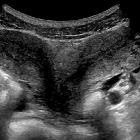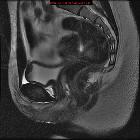Müllerian duct anomaly classification

Septate
uterus • Uterine anatomical abnormalities (illustrations) - Ganzer Fall bei Radiopaedia

Müllerian
duct anomaly classification • Mayer-Rokitansky-Küster-Hauser syndrome - Ganzer Fall bei Radiopaedia

Uterine
duplication anomalies • Bicornuate uterus - Ganzer Fall bei Radiopaedia

Herlyn-Werner-Wunderlich
syndrome • Uterus didelphys with hematometrocolpos - Ganzer Fall bei Radiopaedia

Uterine
duplication anomalies • Bicornuate uterus - Ganzer Fall bei Radiopaedia

Uterine
duplication anomalies • Septate uterus with ovarian pathologies - Ganzer Fall bei Radiopaedia

Müllerian
duct anomalies • Arcuate uterus - Ganzer Fall bei Radiopaedia

Müllerian
duct anomaly classification • T-shaped uterus - Ganzer Fall bei Radiopaedia

Müllerian
duct anomalies • Unicornuate uterus - type B - Ganzer Fall bei Radiopaedia

Müllerian
duct anomaly classification • Uterine hypoplasia - Ganzer Fall bei Radiopaedia

Müllerian
duct anomaly classification • Uterine hypoplasia - Ganzer Fall bei Radiopaedia

Uterine
duplication anomalies • Bicornuate uterus with triamniotic dichorionic triplet pregnancy (3D ultrasound) - Ganzer Fall bei Radiopaedia

Septate
uterus • Complete septate uterus with duplicated cervix - Ganzer Fall bei Radiopaedia

Uterine
duplication anomalies • Partial bicornuate uterus with bilateral tubal block - Ganzer Fall bei Radiopaedia
The Müllerian duct anomaly classification is a seven-class system that can be used to describe a number of embryonic Müllerian duct anomalies:
- class I: uterine agenesis/uterine hypoplasia
- a: vaginal (uterus: normal/variety of abnormal forms)
- b: cervical
- c: fundal
- d: tubal
- e: combined
- class II: unicornuate uterus/unicornis unicollis, ~15% (range 6-25%)
- a: communicating contralateral rudimentary horn contains endometrium
- b: non-communicating contralateral rudimentary horn contains endometrium
- c: contralateral horn has no endometrial cavity
- d: no horn
- class III: uterus didelphys, ~7.5% (range 5-11%)
- class IV: bicornuate uterus: 2nd most common type ~25% (range 10-39%)
- a: complete division, all the way down to the external os (bicornuate bicollis)
- b: partial division, not extending to the internal os (bicornuate unicollis)
- class V: septate uterus: commonest anomaly, ~45% (range 34-55%)
- a: complete division, all the way down to the internal or external os
- b: incomplete division, involving the endometrial cavity but not the cervix
- class VI: arcuate uterus, ~7%
- class VII: in utero diethylstilbestrol (DES) exposure (T-shaped uterus)
See also
Siehe auch:
- Uterus
- Uterus didelphys
- Uterus arcuatus
- Fehlbildungen der Gebärmutter
- Uterus septus
- Uterus bicornis
- Uterus unicornis
- Müller-Gang
- t shaped uterus
- Uterusagenesie
und weiter:

 Assoziationen und Differentialdiagnosen zu Müllerian duct anomaly classification:
Assoziationen und Differentialdiagnosen zu Müllerian duct anomaly classification:






